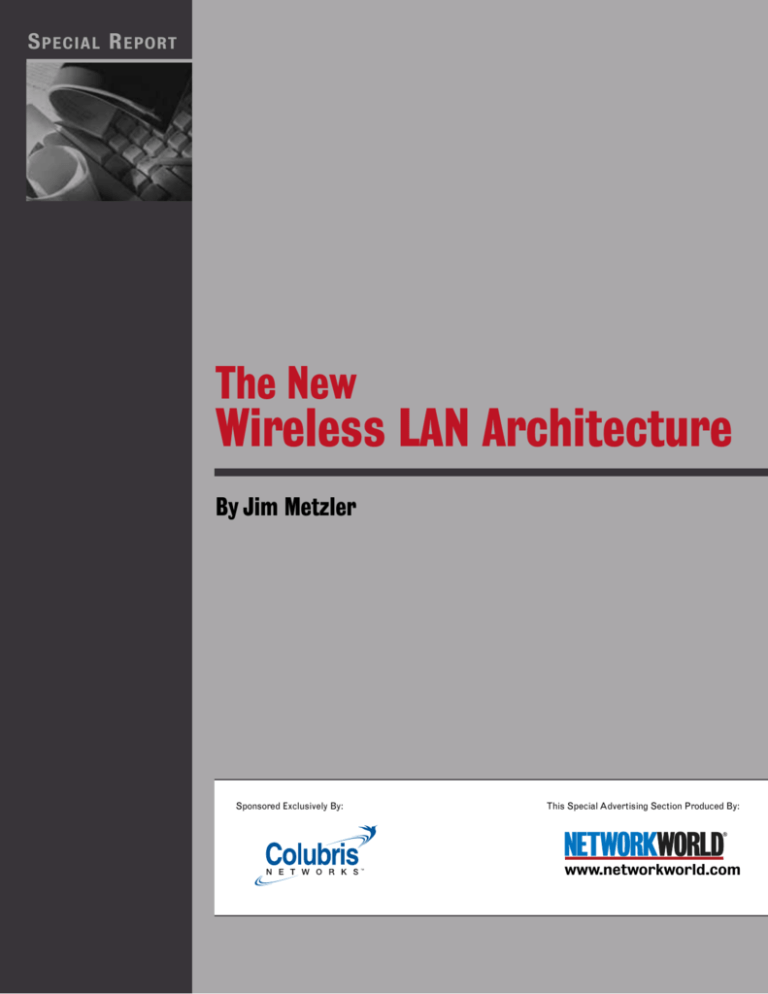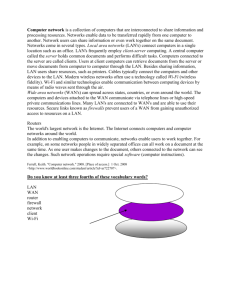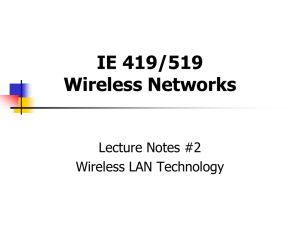
S PECIAL R EPORT
The New
Wireless LAN Architecture
By Jim Metzler
Sponsored Exclusively By:
This Special Advertising Section Produced By:
www.networkworld.com
S PECIAL R EPORT
The New Wireless LAN Architecture
Organizations of all types and sizes are under relentless pressure to become continually more agile. An agile organization is an organization that can efficiently
respond in real-time to any factor in the environment that significantly impacts the
health and well being of the organization and its stakeholders.
Table of Contents
3
The 1990s
LAN architecture
4
The challenging
business environment
5
The need for services
8
The new WLAN
architecture
10
Deployment options
11
Call to action
The requirement to be agile applies at different, but related levels inside of an organization. For example, an organization must be agile to respond to shifts in the business environment, such as the emergence of a new competitor or the opening of new
markets. In addition, the IT function within that organization must be agile in its
ability to incorporate new technologies, as well as its ability to respond to, or even
anticipate, changes in the expectations of the company’s business unit managers.
The purpose of a network architecture is to ensure the agility of the network organization in a cost-effective manner. Without an effective network architecture, networks
typically evolve by deploying a new solution for each new business requirement. This
approach leads to a network infrastructure that is comprised of a wide range of technologies, and which is both expensive and time consuming to maintain and modify.
However, just having a network architecture is not sufficient to ensure the agility
of the network organization. To be effective, a network architecture must provide
a clear linkage between an organization’s business objectives and the services that
are provided by the organization’s network infrastructure. In addition, the network
architecture must drive decisions around the acquisition and deployment of products and technologies.
This special report is focused on the wireless LAN (WLAN) component of an organization’s overall network architecture. This report should help you create an outline of a WLAN architecture that tightly integrates with the existing LAN architecture
and which enhances the agility of the network organization. This report will briefly
analyze the shift in LAN architectures that occurred in the late 1990s, and will
demonstrate how those shifts were in response to specific business and technology
trends. As part of this analysis, this report will highlight some key principles relative to the development of an effective LAN architecture. This report then will highlight some of the primary business and organizational trends that are impacting the
LAN and suggest a network architecture that enables network organizations to
respond to those trends.
About the Author
Jim Metzler is is a principal in Ashton, Metzler & Associates, a consulting
firm that focuses on leveraging technology for business success. During his
career, he has worked in virtually every major segment of the IT industry.
2
S PECIAL R EPORT
3
The New Wireless LAN Architecture
The 1990s LAN architecture
An architecture is intended to be relevant for a number of
years. However, on a periodic basis, changes in the environment are significant enough to justify modifying an existing
architecture. In most cases these environmental changes
involve a shift in business requirements combined with the
development of new technologies. This section follows the
fundamental shift in LAN architecture that occurred in the
1990s and will highlight some key principles relative to developing an effective LAN architecture.
One of the most common LAN designs in the early 1990s
consisted of shared Ethernet workgroups interconnected by
FDDI. However, the mid 1990s marked the beginning of a fundamental shift in business requirements. In that timeframe
companies began to deploy increasingly faster PCs to
respond to the movement to client server computing. As a
result, network organizations began to reduce the number of
users that they assigned to an Ethernet segment.
At the same time that shifting requirements were driving the
movement toward having fewer users on an Ethernet segment, there was an increased focus on the operational
efficiency of the LAN infrastructure. In particular, driven by
the desire to reduce the complexity associated with server
management, IT organizations began the process of centralizing servers. The process of server consolidation
underscores an important architecture principle.
Architecture Principle #1: Centralized management is a requirement for a network to scale.
As organizations began to consolidate servers, there was a
series of technological advances that led to the deployment
of the first generation of LAN switches. These LAN switches
made it economically feasible to dedicate an Ethernet segment to an individual user.
This combination of shifting requirements, an increased focus
on operational efficiency, and the deployment of LAN switching
led to both the need and the ability to migrate the enterprise
LAN architecture away from one based on shared media, and
towards one based on switching. Figure 1 depicts the migration
that most companies went through in this time frame.
Figure 1: Migration to The Switched LAN Architecture
Access
WIRING
CLOSET
Hubs
Layer 2
Switches
Router
Layer 3
Switch
Sit
SITE
BACKBONE
FDDI
CAMPUS
BACKBONE
EVOLUTION
MIGRATION
Layer 2 or Layer 3
Switches
Distribution
Core
The architecture that is depicted on the right of Figure 1 is The
Switched LAN Architecture. The Switched LAN Architecture is
comprised of a hierarchical three-tier design that corresponds to
the physical topology of a company’s wiring closet, site backbone and campus backbone. Note that the three tiers of The
Switched LAN Architecture are often referred to as access, distribution, and core.
S PECIAL R EPORT
The New Wireless LAN Architecture
While it is possible to put Layer 3 switches in the wiring closets, that results in significantly increasing the complexity of
ongoing management. Driven by the previously mentioned
principle of reducing complexity, virtually all companies populate their wiring closets with Layer 2 switches.
A key characteristic of first generation LAN switches is that
similar to the shared hubs that they were replacing, these
switches were designed primarily to provide raw connectivity
and not to provide any significant value-added functionality.
This changed quickly. In particular, companies soon adopted
a LAN architecture that called for deploying switches that supported advanced functionality by incorporating the ability to
process packets at layers 4 and higher. This allows a LAN to
implement value-added services such as QoS.
Architecture Principle #2: A network architecture needs to be able
to support enhanced services in addition to just raw connectivity.
It would have been possible to implement processing at
Layer 4 and above only in Layer 3 switches in the distribution
and core layers. However, driven by the need to support
demanding applications such as VoIP, the vast majority of
companies have implemented a LAN architecture that calls
for the Layer 2 switches in the wiring closet to be able to
process at Layer 4 and above. Hence, while architecture principle No.1 called for the centralization of management
functionality, the deployment of sophisticated functionality
in wiring closet switches leads to a complementary architecture principle.
Architecture Principle #3: Distributed processing is required both
for scalability and for the ability to support enhanced services.
Like all network technologies, the first generation of LAN
switches was relatively expensive and lacked high throughput. For example, first generation LAN switches typically
provided a small number of ports, most of which were running at 10M bit/sec. In addition, most of these switches could
not support all of the ports running at wire speed. However,
within a couple of years, the per-port prices dropped, and
LAN switches began to support a large number of ports running at wire speeds up to a gigabit per second.
Architecture Principle #4: Networks in general, and LANs in particular, need to be able to scale to support continually increasing
levels of throughput.
While today’s switched LANs are comprised almost exclusively of Ethernet, it is important to realize that in the mid
1990s there were a number of switched LAN technologies. In
addition to some proprietary technologies, these technologies included Ethernet, Token Ring, FDDI, ATM and
100VGAnyLAN.
Architecture Principle #5: Network architectures tend to focus
on a small set of standards-based technologies and industry standard practices.
The challenging business environment
The requirement for agility, combined with the growing
need to support a mobile workforce, has spawned the
requirement for companies to provide employees access to
corporate applications, whether the employee is at his usual
workspace, at another office in his primary place of employment, or at an airport or hotel.
The need for agility is driven in part by the relentless
pressure of competition, which has reduced most business’s ability to raise prices. This has led to the general
business requirement to control costs in general, and IT
costs in particular.
While these trends apply to virtually all organizations, each
industry segment has its own unique challenges. An example
of that is the medical industry. Over the last few years there
has been increased public awareness of the need to improve
the quality of medical care. This awareness typically comes
from incidents that are reported on the evening news, and
backed up by studies of the healthcare industry.
For example, a 1999 report from the Institute of Medicine
(IOM) highlighted the seriousness of the issue. The IOM
report quoted studies that indicated that medical errors in
U.S. hospitals result in the death of 44,000 to 98,000 people
each year.
The healthcare industry also is in the midst of an ongoing
labor shortage. One component of this labor shortage
4
S PECIAL R EPORT
The New Wireless LAN Architecture
involves nurses. More than 126,000 nursing positions are
unfilled today and that number is expected to increase significantly just as the Baby Boomers begin to place even more
demands on the system.
The myriad challenges that every company faces have
resulted in intense pressure on the IT organization to demonstrate its business value. This pressure to demonstrate the
business value of IT is summarized in a story entitled “IT
Doesn’t Matter”1 . Author Nicholas Carr suggests that IT has
become a commodity and hence no longer provides an
organization with a strategic advantage. Based on this
assumption, Carr urges organizations to reduce how much
they spend on IT.
Carr’s story has encouraged IT organizations to focus on providing value-added services and not just commodity
technologies. The creation of a network architecture enables IT
organizations to establish a clear linkage between business
requirements and the services that the IT organization provides.
The need for services
Background
One of the techniques that IT organizations can use to provide business value and yet control costs is to deploy a single
network infrastructure over which they create multiple virtual networks. For example, many companies use MPLS WAN
services from one or more service providers. These MPLS
WAN services offer multiple service classes that are engineered to support disparate traffic types.
For the sake of example, assume that a service provider’s
MPLS network offers four service classes. The enterprise IT
organization may use these four classes to offer the following services:
• Voice
• Video
• High priority data transport
• Low priority data transport
1
IT Doesn't Matter, Nicholas Carr, Harvard Business Review, 2003
This approach is in close alignment with the need to be
able to layer value-added services on top of basic connectivity. However, this requirement is not limited to the WAN, it
extends also to the LAN. One of the implications of this
requirement is that IT organizations need to deploy a WLAN
architecture that facilitates the ongoing deployment of valueadded services.
Another implication of this requirement is that IT professionals must acquire WLAN equipment from a vendor that
provides a wide range of services. However, it is just as important that IT professionals acquire WLAN equipment from a
vendor that supports an open environment that enables third
parties to develop additional services.
The purpose of this section is to provide some examples
of possible services to be layered on top of an organization’s WLAN. This is not intended to be an exhaustive list of
possible services.
To demonstrate the recognition in the marketplace of the
need for services, this special report will refer to market
research contained in the document “Wireless LAN State-ofthe-Market Report” that was authored by Joanie Wexler
(www.webtorials.com). Throughout this special report, that
document will be referred to as The WLAN Report.
5
S PECIAL R EPORT
The New Wireless LAN Architecture
intend to provide this service within the next 24 months.
There were 419 respondents to the survey.
To create The WLAN Report, Wexler asked the subscribers to
Webtorials a number of questions relative to their current and
planned use of WLANs. For example, Wexler asked the survey
respondents about the applications that they intended to run
over their WLANs. Their responses are shown in Figure 2.
One industry segment where creating linkages with legacy
systems is critical is the medical industry. As mentioned, two
challenges facing the medical industry are increasing the
quality of medical care and leveraging an
increasingly scarce supply of nurses.
Figure 2: Plans for WLAN Applications
Percentage of Respondents
0%
10%
20%
30%
40%
50%
60%
70%
80%
E-mail and other business
applications
66%
22%
Employee Internet access
67%
21%
Guest intranet/Internet
access
90%
100%
27%
45%
To respond to these challenges, hospitals and other care facilities are providing
wireless devices to their nurses. By using
WLAN technology, these devices are
linked to clinical information systems.
One of the goals of establishing this linkage is to inform a nurse in advance of any
potential adverse consequence that
might result because of administering a
drug or other form of treatment.
Value-added services
Video
44%
21%
Voice
28%
11%
Guest services
Already deploying
Within the next 24
months
Asset tracking
Point of sale
verification/transactions
22%
11%
9%
13%
Source: The WLAN Report
Legacy services
While it is critically important that the new WLAN architecture enable IT organizations to offer new value-added
services, it is also extremely important that the new WLAN
architecture support any existing services. This requirement
is demonstrated in Figure 2. In that figure, 66% of companies
already use their WLANs to provide access to e-mail and
other business applications. An additional 22% of companies
This class of service is targeted at visitors to a building or campus complex. As
is shown in Figure 2, 45% of companies
already offer this service and an additional 27% of companies intend to provide
this service within the next 24 months.
A major part of the challenge in providing guest services is that there is a wide
range of types of guests that must be
accommodated. Because of that, it is critical to authenticate all guests.
For example, the authentication process may determine
that the guest is an employee of the organization who normally works at another location. In this case, it might be
desirous to provide the employee access to corporate applications and to ensure that the employee’s traffic gets the
appropriate QoS treatment. However, if the authentication
process determines that the guest is a contractor or someone
who is there to make a sales call or apply for a job, it may be
desirous to tightly constrain the resources to which the guest
6
S PECIAL R EPORT
7
The New Wireless LAN Architecture
has access. In some cases, the guest may be constrained to
only have Internet access.
VoWi-Fi
professionals no matter what technology is being discussed.
In particular, as shown in Figure 3, for the last two years security is far and away the most significant challenge impacting
the deployment and justification of WLANs.
Another service that is beginning to be widely deployed is
transporting voice
over a WLAN. This
Figure 3: Top Challenges in Deploying or Justifying WLANs
service is commonly
Percentage of Respondents
referred to as VoWi-Fi.
0%
10%
20%
30%
40%
50%
As is shown in Figure
Security concerns
2, 21% of companies
already offer this servManaging/troubleshooting the wireless infrastructure
ice and an additional
Interference/performance problems
44% of companies
Lack of multivendor interoperability
intend to provide this
Configuring and upgrading large numbers of dispersed access points
service within the
Supporting fast user roaming across IP subnets
next 24 months.
60%
70%
80%
Lack of inhouse RF expertise
To ensure acceptable voice quality,
VoWi-Fi
requires
QoS. In a growing
number of cases,
these VoWi-Fi deployments also include
Session
Initiation
Protocol because of
the broad range of
applications that can
be enabled in a SIPbased solution.
Too many or confusing technology standards
Integration with wired network
2005
2004
High equipment prices
Conducting site surveys
Wireless LANs not needed
High operations costs/total cost of ownership
Other (please specify)
Lack of budget*
Waiting for rapidly changing market/products to settle*
One application of VoWi-Fi is for people who want to have
one phone to use both in fixed locations, such as their home
or office, as well as while they are traveling. To provide this
service, the phone call must seamlessly switch between the
WLAN in the building and the person’s cell phone service
provider outside of the building.
Security
Security can be viewed both as a service unto itself as well
as a service that enhances the value of other services. In
either case, security is a top of mind issue for virtually all IT
* Not offered as response option in 2004.
Source: The WLAN Report
The IEEE is addressing security through a variety of new
standards. One such standard, 802.1X, is focused on port
based network access control and provides an authentication framework that is applicable in both wired and wireless
environments. A key concept within the 802.1X standard is
identity. In this context, identity refers to the accurate and
positive identification of network users, hosts, applications,
services and resources. As part of the 802.1X standard, a server will verify a client’s identity to ensure that authorized users
gain access to the appropriate enterprise computing
resources, while unauthorized users are denied access.
S PECIAL R EPORT
The New Wireless LAN Architecture
The recently adopted IEEE 802.11i standard uses 802.1X for
user authentication and key distribution. For encryption, the
802.11i standard requires the implementation of Advanced
Encryption Standard-Counter-Mode Cipher Block Chaining
Message Authentication Code Protocol. This protocol not
only encrypts the packet payload, but it also protects selected packet header fields.
• Meshing protocols
Emerging services
• Advanced security on the controller
While it is critical that IT organizations deploy a WLAN
architecture that can support these existing services, it is also
critical that the WLAN architecture support services that are
likely to emerge over the next few years.
To exemplify this concept, the following highlights
some WLAN-based services and service enhancements
that could emerge and become mainstream over the next
few years.
• Power management
The goal of power management is to optimize battery life
for handheld devices. This service puts to sleep either the
entire WLAN device, or just the WLAN interfaces.
• Location services
These services are intended to identify the location of a
piece of equipment or a person within a building or campus complex. Organizations such as hospitals could use
this service to keep track of life-saving equipment as it
moves throughout the hospital. A service that locates
people could be used to support the E911 requirement
that when someone calls 911, both the calling number
and the location of the caller, must be available to the
911 operator.
• Dynamic allocation of capacity
In many cases it is useful to allocate WLAN capacity to
users when they authenticate themselves using protocols such as 802.1X. This allows an IT organization to
assign different amounts of bandwidth to users based
on the identity of the users and the overall utilization of
the WLAN.
In most current WLAN deployments, each access point is
connected to some form of WLAN switch and not to
another access point. WLAN meshing protocols allow for
direct connectivity between access points. These links
between access points increase both the availability of the
WLAN as well as the number of possible design options.
Two forms of security that are getting a lot of attention are
intrusion-detection systems (IDS) and intrusion-protection
systems (IPS). An IDS is intended to protect the IT infrastructure by detecting inappropriate, incorrect or anomalous
activity as it is happening. Alternatively, an IPS is intended to
prevent any form of wireless attack or intrusion.
The new WLAN architecture
When The Switched LAN Architecture was developed WLANs
were not a reality. As such, support for WLANs was not included in the architecture. Given the broad-based momentum to
deploy WLANs a new architecture needs to be developed. This
architecture must closely integrate WLANs with the existing
LAN architecture and must adhere to the architecture principles developed in section two of this document.
8
S PECIAL R EPORT
Some of the initial deployments of WLANs were based on
simply installing one or more access points. While this solution scaled relatively well, it did not allow for any
coordination among the access points.
Figure 4 depicts the WLAN Switch Architecture that many
companies currently implement. Throughout this document, this architecture will be referred to as the WSA. As
can be seen in Figure 4, within the WSA a proprietary
WLAN switch is the central point for control, management
and data traffic.
such as the type discussed in section four of this document, to the WSA.
What is needed is a WLAN architecture that preserves the
advantages of the WSA while overcoming its disadvantages.
Table 1 lists some of the architectural aspects of the WSA that
lead to its disadvantages. The table also indicates how those
architectural deficiencies could be remedied.
Table 1: Remedying the WSA
Figure 4: WLAN Switch Architecture
Management
Control Data
WLAN Switch
AP
9
The New Wireless LAN Architecture
LAN
AP
The WSA has many advantages. One of these advantages is
security. The WSA provides for strong access control and privacy and also allows for secure roaming. This architecture
also reduces the burden of configuration management and
ongoing operations.
However, the WSA also has many disadvantages. For
example, the WLAN switch is a single point of failure for
all of the access points that are attached to it. In addition, because all of the traffic from the access points
transits the WLAN switch, this switch becomes a performance bottleneck and adds significant cost for
simple data pass through traffic.
Architectural Deficiency
of the WSA
Remedy
The WLAN Switch is a
bottleneck
Eliminate the WLAN switch
A single plane for control,
management and data
Separate control, management
and data planes
Data processing is
centralized
Data process is distributed
Proprietary interfaces
Open interfaces
The Distributed Intelligent WLAN Architecture depicted in
Figure 5 incorporates the remedies suggested in Table 1.
Throughout this document, this architecture will be referred
to as the DIWA.
Figure 5: Distributed Intelligent WLAN Architecture
Management
Plane
NMS
WLAN RF &
system mgt.
Control
Plane
LAN
Client access & QoS
control, roaming
Controller
Another limitation of the WSA is that it is not easily
Data
Client data packet
AP
AP
adapted to accommodate new technologies or servprocessing
Plane
ice offerings. For example, the IEEE is working on a
new WLAN standard 802.11n. This standard will support real data throughput of at least 100 M bit/sec, which
A critical aspect of the DIWA is that it supports the concept
may well require an even higher raw data rate. To support
of a “multi-service virtual access point”. This enables IT organthis standard, the WSA would require a forklift upgrade. In
izations to offer a variety of services over a WLAN.
addition, based on the proprietary nature of the WLAN
switch, it is not easy for third parties to add any services,
The DIWA also supports packet processing in access points.
This approach allows IT organizations to enforce security and
S PECIAL R EPORT
10
The New Wireless LAN Architecture
are highlighted in section two of this document. As can be
seen in Table 2, the DIWA is in tight conformance with
those principles.
Table 2: Evaluating the Distributed Intelligent WLAN Architecture
Architectural Principle
Conformance
Centralized management is
a requirement for a network
to scale.
Both the management and the
control of the WLAN are
centralized.
Network architectures tend
to focus on a small set of
standards-based
technologies and industry
standard practices.
The management, control and
data planes are kept separate
as is the case with all
contemporary architectures.
Networks in general, and
LANs in particular, need to
be able to scale to support
continually increasing levels
of throughput.
There is not a single
performance or availability
bottleneck.
A network architecture
needs to be able to support
services in addition to just
raw connectivity.
Open APIs enable third parties
to have access to information
pertaining to security, location
and QoS.
Traffic processing
intelligence needs to be as
close to the user as possible.
Traffic processing occurs in
access points.
Deployment options
To minimize complexity, an architecture must be able to be
deployed across a range of sites, from a large headquarters
facility to a small branch office.
Figure 6 shows how the DIWA would be deployed inside a
large site in which there are LAN switches on each of the
floors (such as the distribution network) that are connected
by a single core switch. In this case, the Network
Management System and the controller, or possibly a cluster
of controllers, is attached to the core LAN switch. Also
attached to the core switch would be other relevant servers,
such as servers to provide Authentication, Authorization, and
Accounting, VPN and DHCP services to both wired and wireless users.
The functionality is packaged
into a single piece of equipment
for use in small sites.
However, the functionality contained in the DIWA needs
to be integrated into a single piece of equipment for use in
small sites. Figure 7 shows how an integrated device that
functions both as a multi-service controller as well as an
access point would be deployed. In conformance with
architecture principle No.1, the management of the network
is centralized.
bandwidth management at the network edge. This approach also
contributes to the overall scalability and performance of the WLAN.
Similar to The Switched LAN
Architecture, the DIWA as shown
in Figure 5 is intended to be
deployed in large sites. To conform
to standard industry practices, the
bulk of the functionality contained
in the DIWA needs to be contained
in a single piece of equipment for
use in small sites.
To evaluate the viability of any
new architecture such as the
DIWA, it is important to determine
if that architecture conforms to
the architecture principles that
Figure 6: Large Site Deployment
Access Points
Access Points
Core LAN
Switch
10/100 Switch
Floor 2
10/100 Switch
Floor 1
NMS
Controller Cluster
AAA, VPN,
DHCP
Servers
S PECIAL R EPORT
Figure 7: Remote Site Deployment
Remote Sites
Central Site/Campus
Controller
Access Points
Integrated
MultiService
Controller/AP
NMS
AAA, VPN,
DHCP
Servers
11
The New Wireless LAN Architecture
Given the IT organization’s responsibility to leverage its investments,
the most effective and efficient way
to implement a change in architecture is through a process of “cap
and grow”. In this case, “cap and
grow” means that IT organizations
should no longer invest in the
WLAN Switch Architecture but
should continue to use the equipment that is already deployed.
LAN/WAN
Backbone
VLAN
Switch/Router
Call to action
An IT architecture is intended to be relevant for a number
of years. However, on a periodic basis, changes in the environment are significant enough to justify modifying the
architecture. In addition to the changing business requirements outlined in this document, there are a number of
specific IT initiatives that should cause IT organizations to
consider changing their WLAN architecture. These initiatives
include the IT organization’s desire to:
• Expand the current deployment of WLANs
• Deploy services such as VoWi-Fi and hence need intelligence in the access point
• Avoid Single Points of Failure
• Create an integrated wired and wireless LAN infrastructure
• Deploy centralized management of remote sites
• Implement an open environment to efficiently support
applications developed by third parties
• Reduce capital expenditures and operational expenses
• Deploy a network that is large scale, broadly distributed,
and which has sites of all sizes
• Deploy policy management and enforcement
Cap and grow also means that on
an ongoing basis, IT organizations
should deploy the Distributed
Intelligent WLAN Architecture as
shown in Figure 5. This architecture,
which conforms to a broad set of
widely accepted architecture principles, exhibits two key attributes. The first of these
attributes is that the DIW is focused on providing a wealth
of services from both the equipment supplier as well as
from third parties that leverage the architecture’s open
interfaces. The second key attribute is that within the
DIWA, management and service creation are centralized
while packet processing is distributed.
© 2005 Network World, Inc. All rights reserved.
To request reprints of this special report contact
networkworld@reprintbuyer.com









